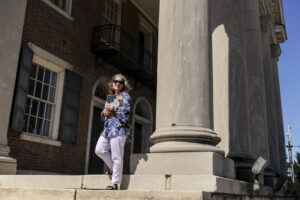Making Strides: Places in north Alabama to explore by walking

By Catherine Godbey | Living50Plus
As people age, the variety of ways to stay physically active shrink. Gone, for many, are the days of full contact football, basketball, wrestling and baseball.
But myriad opportunities remain for individuals to meet the recommended 150 minutes a week of moderate-intensity exercise. Think swimming, gardening, yoga and, one of the most popular activities, walking. Just head to any park, neighborhood or, yes, even mall, to see individuals in stride.
According to the AARP, most adults 50 and older walk daily, whether exercising, leisure walking, hiking or walking a pet.
In April, communities across Alabama will hold free walking tours, combining physical activity with education and entertainment. The statewide walking initiative organized by the Alabama Tourism Department will expose participants to the cultural, architectural and industrial impact of cities and towns in the state.
Held on Saturdays, the hour-long walks, which begin at 10 a.m., are free and wheelchair accessible. Among north Alabama’s participating communities are Decatur, Mooreseville, Athens and Moulton.
In Decatur, participants will learn about the Historic Decatur Union Depot in a walk on April 13 led by David Breland. Meet at the depot, 701 Railroad St. N.W. On April 20, Mary Morgan will lead a walk focused on the builder R.G. Ross. Meet at Westminster Presbyterian Church, 801 Jackson St. S.E. On April 27, the architecture in Old Decatur will be highlighted in a walk led by Caroline Swope. Expect to hear about the gables, shutters, porches and columns on the four-square, Victorian, craftsman, Italianate, art deco, colonial and Tudor homes, Romanesque and gothic churches lining the streets of Old Decatur. Meet at Frazier Park, 309 Cherry St. N.E.
On the weekly walks in Mooresville, one of Alabama’s oldest towns — incorporated in 1818, a year before Alabama became a state — walkers will hear tales of Chickasaw Indians, Union soldiers, United States presidents and Hollywood actors. Participants will see the Church of Christ, where James Garfield preached in 1863, the Brick Church, where cinematographers filmed scenes for “Tom and Huck” and the post office, erected out of logs and handmade bricks in 1840, making it the oldest one in continuous use in the state. To see the inside of the post office before it closes at 10 a.m., arrive at 9:45 a.m., said Mooresville Mayor Nikki Sprader.
Explore the lore and legends of Athens’ historic districts and city cemetery during the Saturday walks. Participants will learn about the architectural styles of the homes, the sacking of Athens by Union Col. John Basil Turchin, the state’s military history and the notable people buried at Athens City Cemetery.
Moulton will hold a tour on April 22 that will include stops at the Civilian Conservation Corps campsite, the old Moulton gin and more. Meet at Sweet Leona’s Ice Cream, 13540 Court St., Moulton.
In Huntsville, walks include an exploration of Twickenham Historic District on April 13 and the Madison Historic District on April 20 and 27.
Other walking and hiking options:
Bankhead National Forest: The Sipsey Wilderness Trail and the Brusky Lake Trail offer wheelchair-accessible paths. The Sipsey Recreation Area trail offers views of waterfalls and sandstone bluffs and picnic tables. The Brushy Lake trail, which Janice Barrett, outreach coordinator for Willd Alabama in Moulton, described as perfect for spring, is lined with wildflowers and offers views of the bluff and lake.
Marbut Bend: The flat 1-mile loop on Buck Island Road in Elkmont takes visitors through a wetland, by a pond created by a beaver dam, through an open field and along the Elk River. Expect to see migratory shore birds, wood ducks, deer, egrets and more. The trail is accessible to wheelchairs.
Wheeler National Wildlife Refuge: The Atkeson Cypress Trail and Wildlife Observation Building Trail are both wheelchair accessible and begin from the Visitor Center on Alabama 67. The half-mile Atkeson Cypress Trail on the south side of the center, snakes through a cypress swamp and wooded area. The 200-yard Wildlife Observation trail winds from the center, through a small section of forest and to the observation building, which overlooks a pond.
Wilson Morgan Walking Trail: The 1.6-mile walking trail at Beltline and Sandlin roads in southwest Decatur loops around Wilson Morgan Park, which features softball fields, soccer fields, tennis courts and a pond frequently visited by geese.
For self-guided walking tours, visit visitdecatural.org/trails.
• A Walking Tour of Historic Decatur, which features the city’s historic districts, Old Decatur and Albany, highlights the houses and buildings built beginning in the early 1800s. Styles highlighted include colonial revival, California cottage, Dutch colonial and Frank Lloyd Wright influences.
• Civil War “Battle for Decatur” walking tour includes 11 historic sites and traces the four-day clash for Decatur in 1864 between Union and Confederate forces.
• Trail of Tears Walking Tour tells the story of Native Americans brought to Rhodes Ferry during their forced removal by the U.S. government in 1837-38. They walked from the banks of the Tennessee River, where they arrived on steamboat, to the railroad station, where they boarded westward bound trains.
